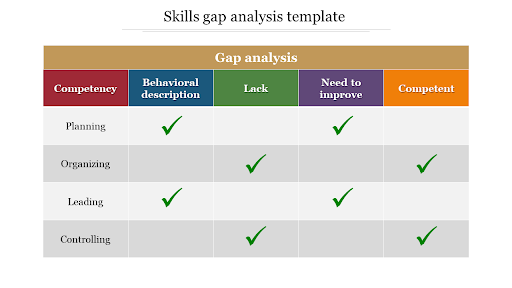Skills Gap Analysis
What is Skills Gap Analysis?
Definition:
Skills gap analysis is a strategic process that assesses the disparity between the skills an organization currently possesses and the skills required to achieve its business objectives. This analysis involves identifying skill deficiencies within the workforce, understanding future skill needs, and implementing targeted solutions to bridge the gap. Through a systematic evaluation, organizations can align their workforce capabilities with evolving demands, fostering continuous improvement and adaptability.
Analogy:
Imagine skills gap analysis as a GPS navigation system for an organization. Just as a GPS identifies the current location and charts the optimal route to the destination, skills gap analysis pinpoints existing skill sets and plots a strategic course to attain the desired skill landscape, ensuring the organization stays on track towards its goals.
Further Description:
Skills gap analysis covers various dimensions of workforce capabilities, including:
Current Skills Assessment: Evaluating the existing skill inventory within the organization, identifying strengths, weaknesses, and areas for improvement.
Future Skills Requirement: Anticipating the skills necessary for the organization to meet its future objectives, considering industry trends, technological advancements, and changing job roles.
Competency Mapping: Aligning specific skills with job roles and organizational goals to create a comprehensive understanding of the skills needed at different levels.
Training and Development Planning: Designing targeted training programs to address skill gaps, enhance employee competencies, and align workforce capabilities with organizational needs.
Recruitment Strategies: Incorporating insights from skills gap analysis into recruitment processes to ensure new hires possess the skills required for current and future demands.
Why is Skills Gap Analysis Important?
Strategic Alignment: Skills gap analysis ensures that the organization’s workforce is strategically aligned with its business objectives, promoting efficiency and goal attainment.
Adaptability: By identifying evolving skill needs, organizations can proactively prepare for industry changes and technological advancements, fostering adaptability.
Employee Engagement and Retention: Addressing skill gaps through training and development programs enhances employee satisfaction, engagement, and retention.
Competitive Advantage: Organizations that continuously analyze and bridge skills gaps gain a competitive edge by staying ahead of industry trends and evolving demands.
Examples and Usage:
Training Needs Assessments: Surveys, performance reviews, and skill assessments help identify specific areas where employees may lack the necessary skills.
Succession Planning: Identifying potential gaps in leadership and critical roles, enabling the organization to groom and prepare employees for key positions.
Technology Skill Assessments: Evaluating employees’ proficiency in relevant technologies to ensure they can effectively leverage tools and systems.
Key Takeaways:
- Skills gap analysis involves assessing current and future workforce skills to align them with organizational goals.
- It includes evaluating current skills, anticipating future needs, and implementing targeted solutions.
- Benefits include strategic alignment, adaptability, employee engagement, and a competitive advantage.
- Examples of skills gap analysis tools and processes include training needs assessments, succession planning, and technology skill evaluations.
Table of Contents





